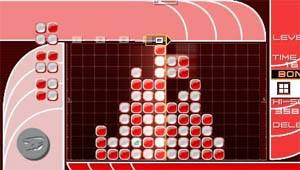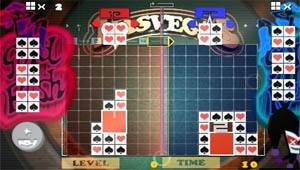|
Lumines
A certain contingent of gamers would have
you believe that video gaming is an artform unto itself: a medium for
creative expression every bit as worthy of critical study and respect as
film or literature. More conservative types suggest the day is coming,
but perhaps hasn't quite yet arrived. But Lumines could well make the
latter argument a little more difficult to support.
Unlike most poster children of the "games as art" movement, Lumines
isn't simply quirky abstraction or a furtive effort to fuse Hollywood
sensibilities with occasional bursts of interactivity. It falls instead
under the same banner as its predecessor, Tetris: a falling block game,
somewhere between a jigsaw puzzle and a chess-like exercise in strategic
visualization. And just as Alexei Pajitnov's brilliant creation was the
killer app for Nintendo's Game Boy, Lumines embodies everything Sony
hopes to achieve with the PSP. Like the system, the game itself is about
convergence: A compelling synthesis of music, video and gameplay.
Of these elements, music is definitely the most crucial, the pivot
around which the rest of the game revolves. This probably shouldn't be
too surprising, coming as it does from Sega's former United Game Artists
star Tetsuya Mizuguchi. His previous creations Space Channel 5 and Rez
also featured a brilliant, musically-focused blend of style and
substance. With Lumines, Mizuguchi seems to be drifting further from the
MTV music video approach of Space Channel 5 and more toward a sort of
stylized minimalism.
At its heart, Lumines is the Tetris concept simplified as far as it can
conceivably be reduced. The falling objects are perfect squares divided
into four smaller blocks of two colors; the descending units can be
rotated, moved side to side and dropped. When four similarly-colored
block segments are connected in a two-by-two arrangement, they vanish
and cause any blocks above to drop down. Occasionally special blocks
will appear which, when cleared, will delete all connected blocks of the
same color.
What differentiates Lumines from the standard Tetris-alike is its
emphasis on the soundtrack. The best puzzle games have traditionally
featured excellent tunes, but in Lumines the music actually affects the
action. A scrolling line traverses the playing field in time to the
current beat; when you create a two-by-two formation, the connected
blocks are marked to vanish. However, they don't actually disappear from
the playing field until the timeline (moving to the tempo of the song)
passes through them. Timing your actions is a crucial component of
successful play. Drop a block too soon and you might clear only a
portion of your selected blocks; drop too late and you could lose a
perfect combo opportunity. It's easily one of the most affecting
interactive experiences to come along in ages -- the kind of game you
continue playing in your mind long after you switch the system off.
The focus on music adds to the experience on a number of levels. Beyond
the obvious fact that the soundtrack, featuring Japanese acid jazz
regulars like Mondo Grosso and vocalist Eri Nobuchika is profoundly
excellent by any measure, the added element of the scrolling timeline
adds a subtle touch of complexity to what might otherwise be something
too basic. It also provides a sense of progress -- as you continue to
play, one tune fades into the next, the timeline changes its speed, and
the audio-visual elements transition from one audio-visual "skin" to the
next.
Perhaps most impressive is the fact that as you play, you effectively
create the game's soundtrack. In addition to its specific tunes and
visuals, each skin includes a set of sound effects triggered by the
player's actions: Moving and rotating blocks, clearing pieces and
creating combinations produces a layer of interactive sound that
nevertheless manages to work in perfect syncopation with the backing
track. It's this subtle sense of control that truly makes Lumines so
absorbing; you're not simply clearing blocks, you're laying down a
groove over the game's fantastic rhythms and creating a light show to
match. You are, in effect, the DJ for the Lumines experience, mixing a
dazzling concert for an audience of one.
If Lumines has a single significant flaw, it's the linear nature of the
game's progress. Skins always appear in a set sequence. When you're on
your twentieth attempt at working up a high score in Challenge Mode and
you know exactly when each tune is going to bleed into the next, the
predictability seems almost banal, which is especially unfortunate in
such an otherwise exotic and style-oriented game. A randomization option
to let the game cycle unpredictably through all the available skins
would have been quite welcome -- after all, no DJ worth his salt would
spin the exact same set night after night.
Of course, it's easy to throw around terms like "art," "convergence" and
"synaesthetic experience," but the true test of a game is something much
more mundane: Is it fun? Lumines hit our offices with an addictive fury
matched only in recent memory by Burnout 3 and Katamari Damacy. High
scores became the key to bragging rights; editors on several occasions
had to forcibly pry their subordinates away from the game to get them
back to work. Yet Lumines also works on a level beyond catchy gameplay.
Q Entertainment has used the Tetris template to duplicate a
lightning-in-a-bottle feeling equal in brilliance and addictiveness to
the puzzle classic. While not the most immediately impressive PSP launch
title, its depth and addictiveness make it likely to be the most
enduring. Once the initial excitement of seeing PS2-calibre visuals on
the go wears thin, Lumines will likely still be driving players to shoot
for new scores and unlock that last elusive skin.

 |